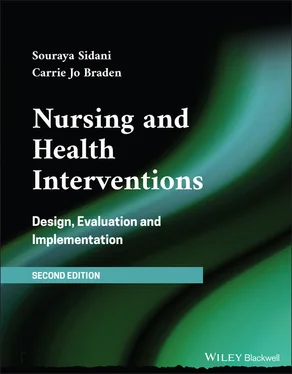Step 3 – Analysis of Theories
The analysis of theories consists of the following:
1 The analysis begins by extracting from the selected sources, information on the following elements of each theory identified as relevant to the health problem: name of the theory; conceptual definition of the problem; operational definition of the problem; and possible variations in its indicators across client populations, subgroups comprising a population, and contexts; specification of determinants at different levels; definition of each determinant; delineation of the relationships (direct, indirect) among determinants and the health problem; conceptual explanation of the proposed relationships; and if available, empirical evidence supporting the proposed relationships.
2 The information pertaining to each theory is synthesized across all sources in order to generate a full and accurate description of the theory and its elements. The description is entered into a matrix illustrated in Table 3.2, in preparation for the analysis.
3 The analysis is done for each theory to determine its logical coherence (i.e. consistency between conceptual and operational definitions, logical explanation of the proposed relationships), usefulness in generating a comprehensive and in‐depth understanding of the health problem (e.g. comprehensive list of determinants at different levels), and applicability to the context of the target client population (Mayne, 2017; The Improved Clinical Effectiveness through Behavioral Research Group, 2006). TABLE 3.2 Matrix for analysis of theories.Element of theoryTheory 1Theory 2NameConceptual definition of health problemOperational definition of health problemDefining indicatorsVariations in indicatorsDeterminantsList of determinants at each levelDefinition of determinantsDirect determinantsIndirect determinants:MediatorsModeratorsConceptual explanation ofDirect relationshipsMediated relationshipsModerated relationshipsEmpirically supported relationships
4 The analysis is also done across theories. This analysis consists of comparing and contrasting, qualitatively, the different elements of the theories, as well as their logical coherence, usefulness, and applicability. The results indicate whether (1) a particular theory is most appropriate, logical and consistent with the initial clarification of the problem experienced by the client population within the context of interest; this theory is selected as the theory of the health problem; (2) elements of different theories are complementary or provide supplementary information about the problem and its determinants; these elements are integrated into the theory of the health problem to present a complete and clear understanding of the problem and its determinants; or (3) a theory or integrated elements is(are) useful in understanding the problem but its(their) applicability to the target client population and context cannot be confirmed; in this case, other approaches (e.g. empirical, experiential) could be used to generate the theory of the problem.
The information gained from this analysis assists in formulating the theory or logic model of the health problem. Specifically, the initial definition of the problem is refined as needed. A comprehensive list of determinants is generated and their direct and indirect relationships with the problem are delineated and explained, and where available, supported by empirical evidence.
The theoretical approach to generate an understanding of the health problem is advantageous. Theories provide a generalizable conceptualization of the problem and its determinants (Foy et al., 2007). By transcending individual cases, middle range theories describe clearly the nature of the problem and identify its determinants or “root causes” (Davidoff et al., 2015). They provide explicit, logical explanations of why and how the determinants affect the problem directly or indirectly. Thus, theories prevent the danger of (1) mislabeling and vaguely defining health problems, (2) missing or omitting important determinants; and (3) misinterpreting associations (specifically bivariate ones that link the problem to one determinant) between the determinants and the problem, all of which have the potential to mislead the design of interventions. Middle range theories do not only explain the pathways linking the determinants to the problem, but also point to the context under which the problem is experienced and maintained, and the pathway is induced. Variations in the pathway across clients and contexts highlight the need to adapt or tailor the design of interventions. Briefly, theories are powerful tools to understand the health problem and to make informed decisions when designing interventions (e.g. Aráujo‐Soares et al., 2018; Bleijenberg et al., 2018; Medical Research Council, 2019).
The theoretical approach has some limitations in gaining a comprehensive understanding of the health problem. The reliance on one single middle range theory constrains the perspective on the nature and determinants of the problem to those identified in the theory. Therefore, additional factors (in particular contextual or environmental) that may contribute to the problem could be missed; this limits the capacity to account for all possible determinants pertinent to complex problems experienced by particular client populations in particular contexts. For many health‐related problems there is a limited, if any, number of relevant middle range theories that provide an adequate understanding of the problem and all its determinants. Further, of the available middle range theories, a few have been subjected to extensive empirical test across the range of client populations and contexts, and for those tested (e.g. transtheoretical model), the results are often mixed.
Middle range theories may have limited utility if they are not supported empirically. The theoretical approach can be complemented with the empirical approach to gain a comprehensive and accurate understanding of the health problem as actually experienced in the target client population and context.
The empirical approach relies on systematically generated evidence to gain an understanding of the health problem. The evidence is obtained through these methods: a review of pertinent literature, conduct of primary studies, and/or analysis of available data.
3.3.2.1 Literature Review
Overview
Literature reviews are essential to analyze and synthesize available empirical evidence on the health problem. The literature encompasses primary quantitative and qualitative studies that investigated the problem, as well as reviews that synthesized the evidence on the experience of the problem (i.e. its indicators) and its association with determinants.
Review of Quantitative Studies
Quantitative studies to include in the review are the ones that aimed to describe the health problem and/or to examine its relationships, direct or indirect, with its determinants and consequences within particular client populations and settings. The studies may use different research designs.
Results of descriptive cross‐sectional studies indicate the prevalence of the problem in different client populations and clarify the nature of the problem, its indicators, and level of severity as reported by clients presenting with diverse sociodemographic, cultural, and health or clinical characteristics, at one point in time. Differences in the health problem experience across client populations or subgroups of the same target population have implications for the design of interventions, whereby different components are selected or their delivery is adapted or tailored to variations in the clients' experience of the problem.
Читать дальше












